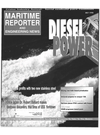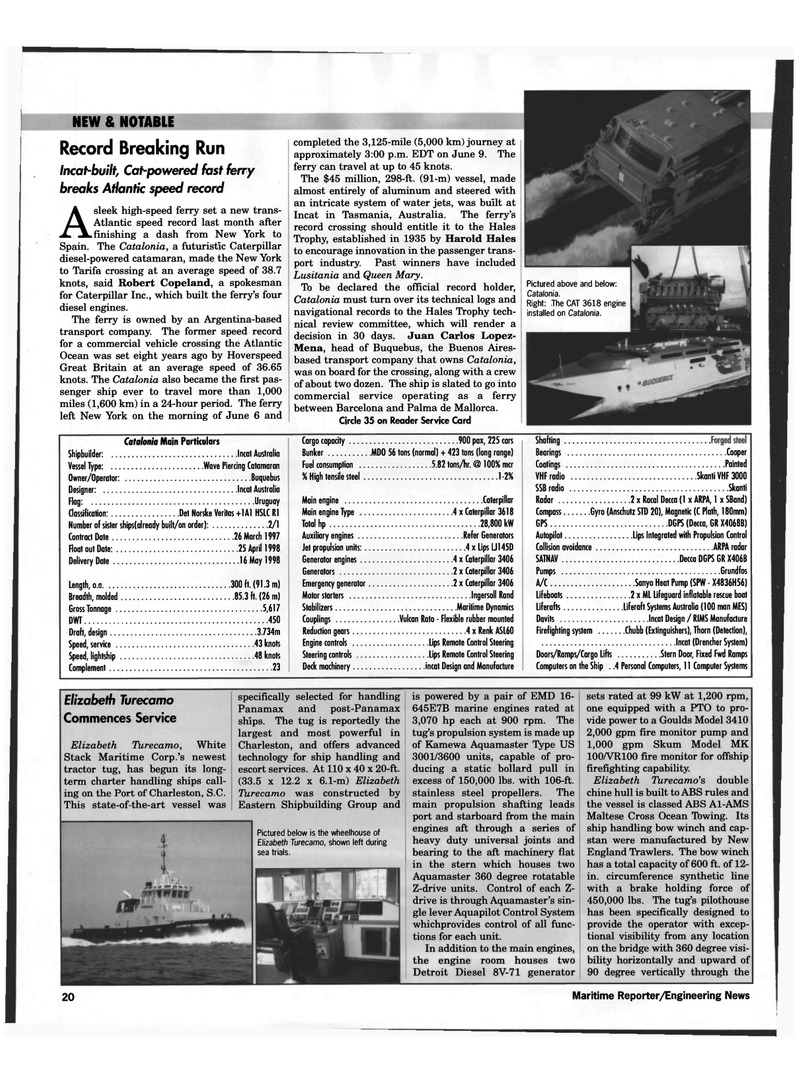
Page 20: of Maritime Reporter Magazine (July 1998)
Read this page in Pdf, Flash or Html5 edition of July 1998 Maritime Reporter Magazine
NEW & NOTABLE
Record Breaking Run
Incat-built, Cat-powered fast ferry breaks Atlantic speed record
Asleek high-speed ferry set a new trans-Atlantic speed record last month after finishing a dash from New York to
Spain. The Catalonia, a futuristic Caterpillar diesel-powered catamaran, made the New York to Tarifa crossing at an average speed of 38.7 knots, said Robert Copeland, a spokesman for Caterpillar Inc., which built the ferry's four diesel engines.
The ferry is owned by an Argentina-based transport company. The former speed record for a commercial vehicle crossing the Atlantic
Ocean was set eight years ago by Hoverspeed
Great Britain at an average speed of 36.65 knots. The Catalonia also became the first pas- senger ship ever to travel more than 1,000 miles (1,600 km) in a 24-hour period. The ferry left New York on the morning of June 6 and completed the 3,125-mile (5,000 km) journey at approximately 3:00 p.m. EDT on June 9. The ferry can travel at up to 45 knots.
The $45 million, 298-ft. (91-m) vessel, made almost entirely of aluminum and steered with an intricate system of water jets, was built at
Incat in Tasmania, Australia. The ferry's record crossing should entitle it to the Hales
Trophy, established in 1935 by Harold Hales to encourage innovation in the passenger trans- port industry. Past winners have included
Lusitania and Queen Mary.
To be declared the official record holder,
Catalonia must turn over its technical logs and navigational records to the Hales Trophy tech- nical review committee, which will render a decision in 30 days. Juan Carlos Lopez-
Mena, head of Buquebus, the Buenos Aires- based transport company that owns Catalonia, was on board for the crossing, along with a crew of about two dozen. The ship is slated to go into commercial service operating as a ferry between Barcelona and Palma de Mallorca.
Circle 35 on Reader Service Card
Cargo capacity 900 pax, 225 cars
Bunker MDO 56 tons (normal) + 423 tons (long range)
Fuel consumption 5.82 tons/hr. @ 100% mcr % High tensile steel 1-2%
Main engine Caterpillar
Main engine Type 4 x Caterpillar 3618
Total hp 28,800 kW
Auxiliary engines Refer Generators
Jet propulsion units: 4 x lips U145D
Generator engines x Caterpillar 3406
Generators 2 x Caterpillar 3406
Emergency generator 2 x Caterpillar 3406
Motor starters Ingersoll Rand
Stabilizers Maritime Dynamics
Couplings Vulcan Rato - Flexible rubber mounted
Reduction gears 4 x Renk ASL60
Engine controls Lips Remote Control Steering
Steering controls Lips Remote Control Steering
Deck machinery incat Design and Manufacture
Catalonia Main Particulars
Shipbuilder: Incat Australia
Vessel Type: Wave Piercing Catamaran
Owner/Operator: Buquebus
Designer: Incat Australia
Flag: Uruguay
Classification: Det Norske Veritas +1A1 HSLC R1
Number of sister ships(already built/on order): 2/1
Contract Date 26 March 1997
Float out Date: 5 April 1998
Delivery Date 16 May 1998
Length, o.a 300 ft. (91.3 m)
Breadth, molded 85.3 ft. (26 m)
Gross Tonnage 5,617
DWT 450
Draft, design 3.734m
Speed, service 43 knots
Speed, lightship .48 knots
Complement 23
Shafting
Bearings Cooper
Coatings Painted
VHF radio Skanti VHF 3000
SSB radio Skanti
Radar 2 x Racal Decca (1 x ARPA, 1 x SBand)
Compass Gyro (Anschutz STD 20), Magnetic (C Plath, 180mm)
GPS DGPS (Decca, GR X4068B)
Autopilot Lips Integrated with Propulsion Control
Collision avoidance ARPA radar
SATNAV Decca DGPS GR X406B
Pumps Grundfos
A/C Sanyo Heat Pump (SPW - X4836H56)
Lifeboats 2 x ML Lifeguard inflatable rescue boat
Liferafts Liferaft Systems Australia (100 man MES)
Davits Incat Design / RIMS Manufacture
Firefighting system Chubb (Extinguishers), Thorn (Detection),
Incat (Drencher System)
Doors/Ramps/Cargo Lifts Stern Door, Fixed Fwd Ramps
Computers on the Ship . .4 Personal Computers, 11 Computer Systems is powered by a pair of EMD 16- 645E7B marine engines rated at 3,070 hp each at 900 rpm. The tug's propulsion system is made up of Kamewa Aquamaster Type US 3001/3600 units, capable of pro- ducing a static bollard pull in excess of 150,000 lbs. with 106-ft. stainless steel propellers. The main propulsion shafting leads port and starboard from the main engines aft through a series of heavy duty universal joints and bearing to the aft machinery flat in the stern which houses two
Aquamaster 360 degree rotatable
Z-drive units. Control of each Z- drive is through Aquamaster's sin- gle lever Aquapilot Control System whichprovides control of all func- tions for each unit.
In addition to the main engines, the engine room houses two
Detroit Diesel 8V-71 generator sets rated at 99 kW at 1,200 rpm, one equipped with a PTO to pro- vide power to a Goulds Model 3410 2,000 gpm fire monitor pump and 1,000 gpm Skum Model MK 100ATR100 fire monitor for offship firefighting capability.
Elizabeth Turecamo's double chine hull is built to ABS rules and the vessel is classed ABS Al-AMS
Maltese Cross Ocean Towing. Its ship handling bow winch and cap- stan were manufactured by New
England Trawlers. The bow winch has a total capacity of 600 ft. of 12- in. circumference synthetic line with a brake holding force of 450,000 lbs. The tug's pilothouse has been specifically designed to provide the operator with excep- tional visibility from any location on the bridge with 360 degree visi- bility horizontally and upward of 90 degree vertically through the
Pictured above and below:
Catalonia.
Right: The CAT 3618 engine installed on Catalonia.
Elizabeth Turecamo
Commences Service
Elizabeth Turecamo, White
Stack Maritime Corp.'s newest tractor tug, has begun its long- term charter handling ships call- ing on the Port of Charleston, S.C.
This state-of-the-art vessel was specifically selected for handling
Panamax and post-Panamax ships. The tug is reportedly the largest and most powerful in
Charleston, and offers advanced technology for ship handling and escort services. At 110 x 40 x 20-ft. (33.5 x 12.2 x 6.1-m) Elizabeth
Turecamo was constructed by
Eastern Shipbuilding Group and
Pictured below is the wheelhouse of
Elizabeth Turecamo, shown left during sea trials. 20 Maritime Reporter/Engineering News

 19
19

 21
21
